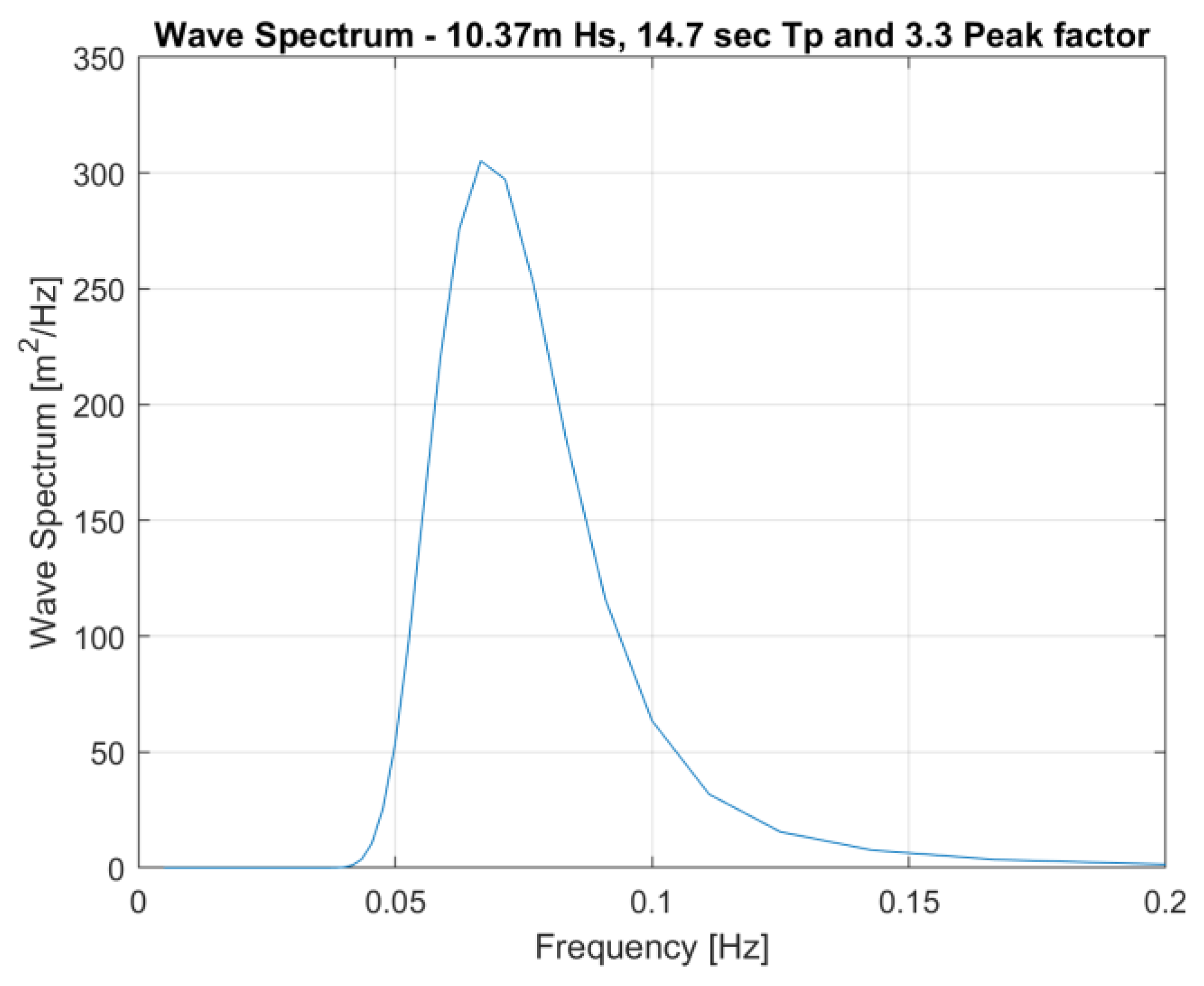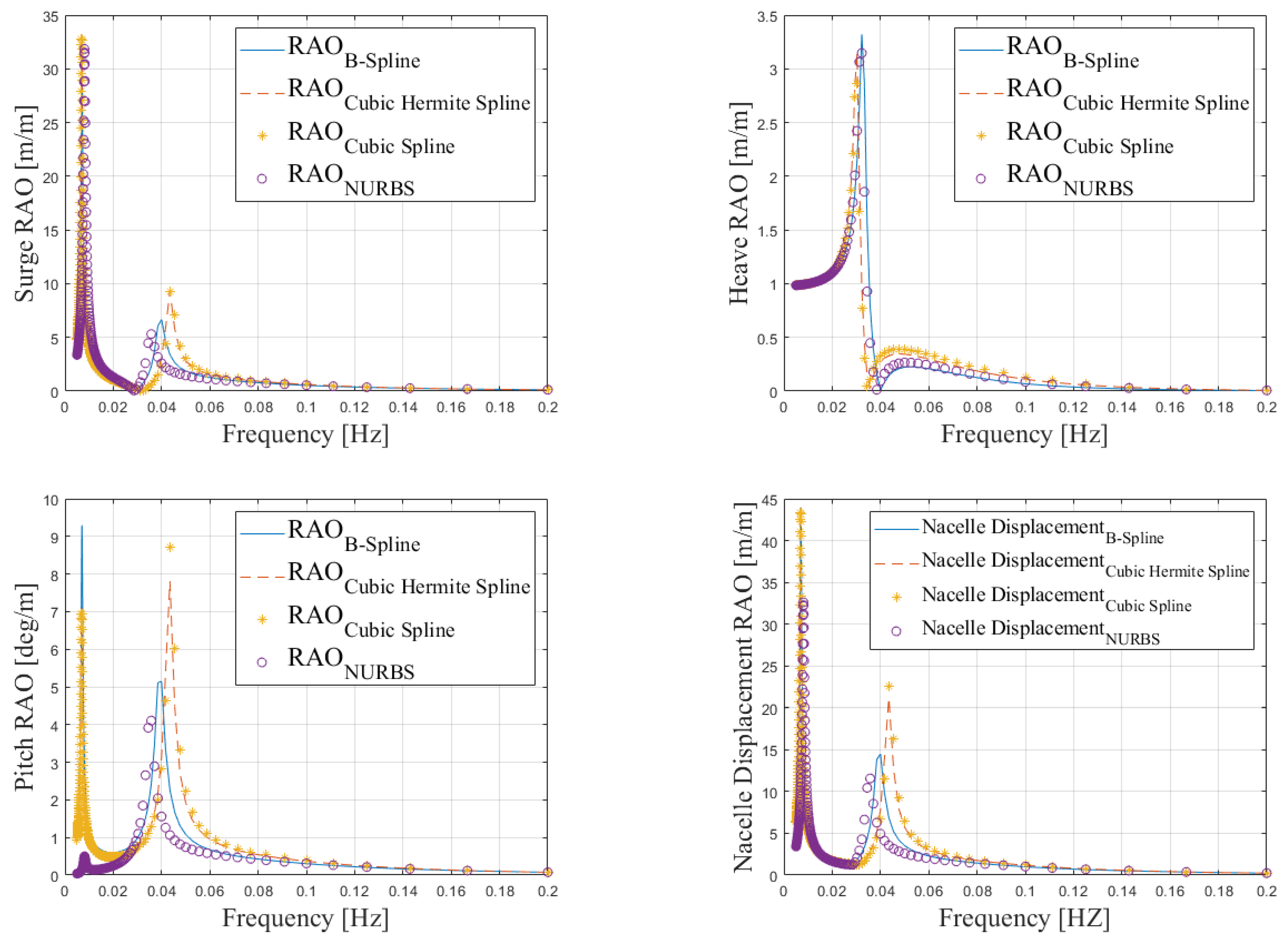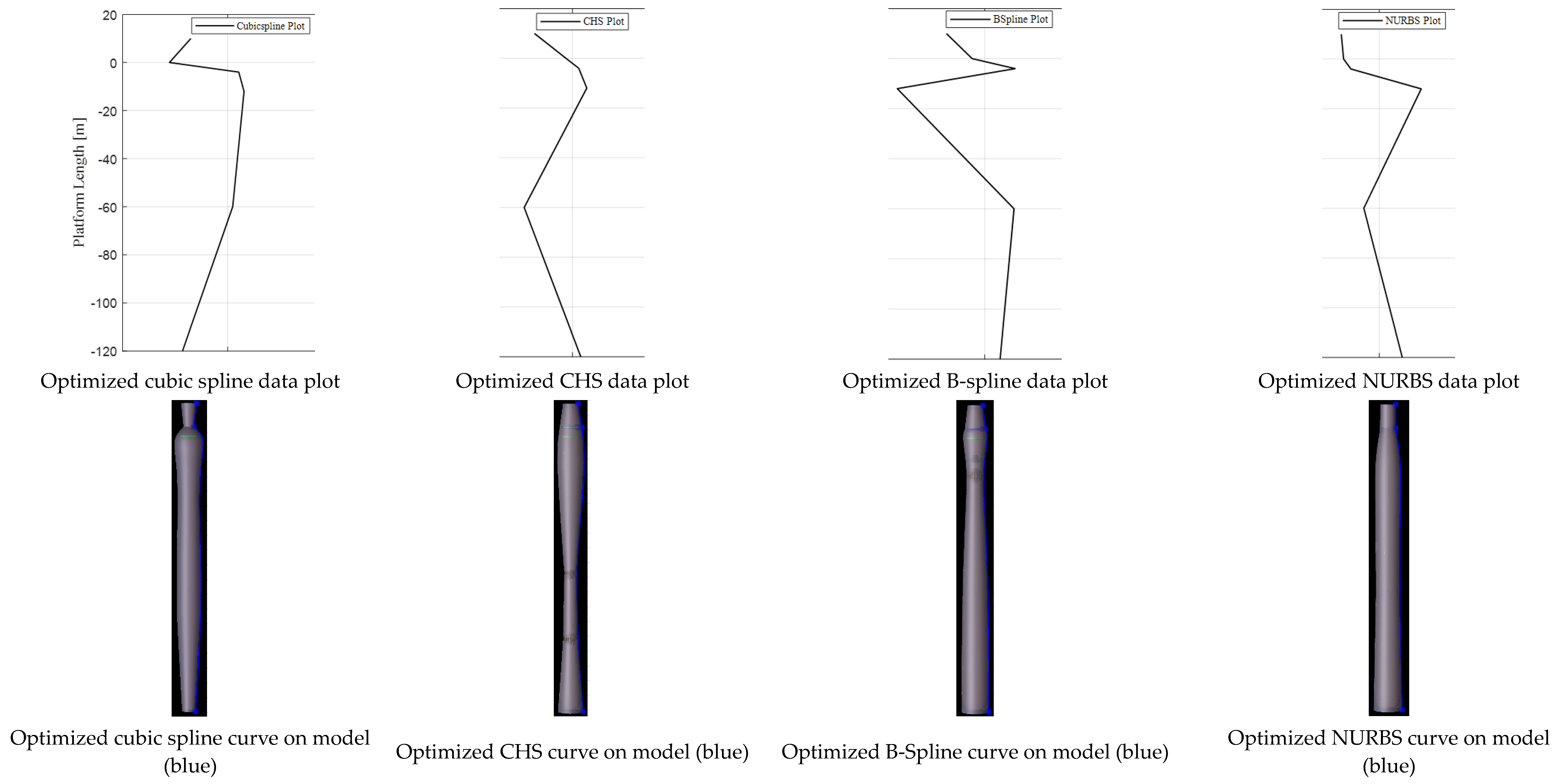4.4.1. Overview
The results from this study are split into three sections highlighted below.
The first section discusses the parametric curve modeling of the OC3 platform with few control points (six control points and five segments), estimating the mass and the system’s response from models of parametric curves using the OC3 dimension [
27].
The second section discusses the shape variation and optimization with the MDAO framework, estimating the system’s response using the developed MDAO framework for all the parametric curves discussed in this article. All optimized curves yielded different shapes according to the specified constraints and objective function.
The third section discusses the ranking of the parametric curves, employing the TOPSIS methodology to rank the best performing curve for the design based on selected performance criteria.
4.4.2. Parametric Curves Modeling and Analysis with OC3 Dimension
The first result section shows the evaluation of the system’s response (nacelle acceleration) and the estimated mass of steel utilized in the design for the free-form parametric modeling curves used with the dimension of the OC3 platform. This estimate has been conducted for the parametric curve used within the MDAO framework conducted in Ojo et al. [
12]. The present analysis goes further by assessing the estimated mass of steel and nacelle acceleration response from other parametric modeling curves (cubic spline, CHS, B-spline and NURBS) using the sea state shown in
Table 4. The data for the design model’s parametric curves considered are presented in
Table 5. The number of control points is reduced to six, as highlighted in
Table 5, in order to reduce the dimensionality of the design space investigated by the MDAO framework. A comparison of the parametric curves on the OC3 design model with a plot of the design data points in
Table 5 is presented in
Figure 3. It is shown in
Figure 3 that all the parametric curves on the model are smooth curves with higher continuity in comparison to the OC3 data plots from
Table 5.
The black plot in
Figure 3 represents a straight line with no continuity used in plotting the radii coordinates of the standard OC3 spar platform highlighted in
Table 5. The black plot in
Figure 3 shows the straight line passing through all the control points highlighted in
Table 5 with high accuracy. However, there is no continuity when the direction of the control point changes. The four other curves in
Figure 3 from left to right are the cubic spline, CHS, B-spline and NURBS curve modeled according to the OC3 coordinates in
Table 5 with various degrees of approximation around the control points. The curves don’t pass through the control points representing all the coordinates in
Table 5 between the first and last coordinates; hence, they are termed approximation curves. Unlike the black straight-line plot in
Figure 3 that passes through all the control point coordinates, the other parametric free-form curves highlighted in blue in
Figure 3 are only guaranteed to accurately pass through the first and last control points and they all exhibit a degree of continuity when the control point direction changes.
The difference in shape of the parametric free-form curves in the blue lines and the OC3 dimension plots in the black lines are due to the unique properties of the free-form curves, amongst which are slope continuity, curvature continuity and the local propagation capabilities of the curve at the control points. A sweep of these curves produces the modeled spar, which represents the wet boundary conditions for hydrostatic and hydrodynamic analysis. A hydrodynamically assessed model of the OC3 spar modeled with the different free-form curves discussed is shown in
Figure 4.
The hydrodynamic assessment of the modeled platforms highlighted in
Figure 3 and
Figure 4 are detailed in
Section 4.4.3, with the system’s surge, heave, pitch and nacelle displacement response assessed with the wave ebergy spectrum in
Figure 5 is highlighted in
Figure 6. The estimated mass from the approximate modeling of the OC3 spar using the free-form curves is highlighted in
Table 6. The nacelle acceleration calculated from the responses presented in
Table 7.
4.4.3. Wave Spectrum and Response Amplitude Operator Results for OC3 Model
The wave energy spectrum for the site is derived from the data provided in
Table 4 and presented in
Figure 5, with a peak wave spectrum of 320 m
2/Hz at a peak period of 14.7 s.
Figure 5.
Wave spectrum—10.37 m Hs and 14.7 s Tp.
Figure 5.
Wave spectrum—10.37 m Hs and 14.7 s Tp.
The surge, heave and pitch response amplitude operators for all the free-form models developed from the dimensions in
Table 5 are represented in
Figure 6.
It is shown in
Figure 6 that for the parametric free-form curves and all the degrees of freedom (surge, heave, pitch) assessed, including the nacelle displacement, the peak responses of the NURBS model and the B-spline model appear to be below the range of first-order wave excitation force frequencies (i.e., the region between ~0.04 Hz to ~0.2 Hz) for the surge and pitch degrees of freedom, while the peak frequencies for the cubic spline model and the CHS model are around the boundary of the first-order wave excitation frequency range for the same degrees of freedom. This shows that the models designed with the cubic spline and CHS may have a larger dynamic response than the configurations obtained with the NURBS and the B-spline approaches. However, the heave response peak is outside the first-order wave excitation region for all the approaches.
The same observation is made with the nacelle displacement response. The geometries obtained with the NURBS and the B-spline approaches show the peak response of the nacelle displacement to be outside the first-order wave excitation region, while the peak response of the geometries from the cubic spline and the CHS are within this region, again increasing the likelihood of a larger dynamic response to waves.
The nacelle acceleration of the parametric free-form curves assessed with the OC3 spar-buoy dimension are highlighted in
Table 7: the CHS free-form curve has the largest nacelle acceleration of 0.111 m/s
2, which is still within the allowable nacelle acceleration value of 20–30% of gravitational acceleration [
28].
Figure 6.
Surge, heave, pitch and nacelle displacement RAO for the four parametric curves.
Figure 6.
Surge, heave, pitch and nacelle displacement RAO for the four parametric curves.
Table 7.
OC3 Nacelle acceleration RMS for the free-form curves.
Table 7.
OC3 Nacelle acceleration RMS for the free-form curves.
| | CS | CHS | B-Spline | NURBS |
|---|
| Nacelle Acceleration RMS (m/s2) | 0.1184 | 0.1110 | 0.0842 | 0.0780 |
4.4.4. Shape Alteration and Optimization with MDAO Framework—Optimized Shape and Response Amplitude Operator Results
The Shape Alteration and Optimization Framework (SAOF) is a platform designed to evaluate the performance of different parametric free-form curves that are integrated into the optimization framework in this study. The SAOF allows for the exploration and modification of curves to optimize their shapes and achieve design objectives and goals.
The shape variation and optimization process results in the selection of the optimal design from the parametric curve and the MDAO framework described in
Section 3. The objective of the MDAO framework is to minimize the mass of steel used for design, which invariably reduces the capital cost of the spar-buoy platform. Also, the result satisfies the static pitch angle constraint of 5 degrees set for all the four free-form parametric curves assessed. Other constraints set are to ensure a positive ballast, which is a way to impose floatability, and also maintain allowable nacelle acceleration as detailed in Ojo et al. [
12]. The results of the optimal shape variants when the objective and constraints are applied to the MDAO framework are discussed in this section. The optimized dimension or data on the varying control points along the different free-form curves are highlighted in
Table 8.
An illustration of the optimal spar variant is shown at the top of
Figure 7 with a straight-line plot that passes through all the optimal variant coordinates/control points from all the parametric free-form curves highlighted in
Table 8. As discussed in
Section 4.4.2, the black plots at the top of
Figure 7 show that the straight line plot of the selected parametric free-form curve’s optimal variants from
Table 8 pass through all the control point highlighted in
Table 8 with high accuracy and no degree of continuity when the control point coordinates change direction.
The model below in
Figure 7 shows the parametric free-form curves in blue from which the models are developed with a curve sweep in Sesam GeniE. As highlighted in
Section 4.4.2, the parametric free-form curves used to develop the selected optimized variant from the MDAO framework show unique properties, amongst which are slope continuity, curvature continuity and local propagation properties which ensure a smooth transition when the control point coordinates change direction.
The results for the hydrodynamic motion response in surge, heave, pitch and nacelle displacement of the selected optimized variants shown in
Figure 7 and
Figure 8 are presented in
Figure 9.
The response results for the optimal shape variants are presented in
Figure 9. The peak response frequency for the surge degrees of freedom, as well as the peak of the nacelle displacement RAO, are well outside the first-order wave excitation range, while the peak response frequency for the pitch degree of freedom is around the boundary of the first-order wave excitation range for all the free-form curves assessed. However, for the heave degree of freedom, the peak response frequency for the CHS free-form curve is within the first-order wave excitation range, which may lead to a larger dynamic response of this platform to typical sea states, while the same does not happen for the other parameterization curves, whose peaks are outside this region.
The other results assessed for the optimal variants selected from each free-form curve are the mass estimate from the hydrostatic analysis highlighted in
Table 9 and the nacelle acceleration computed with the nacelle acceleration root mean square values highlighted in
Table 10. The results show that, from a mass minimization point of view, the CHS provided the best configuration. However, for the nacelle acceleration assessment, it is the B-spline curve that yielded the minimum nacelle acceleration value. The nacelle acceleration results are within the allowable limit of 20% to 30% of acceleration due to gravity, according to Rasekhi Nejad et al. [
34]; hence, selecting the curve to use requires a trade-off of what criteria are most important to the designer/analyst. To address this trade-off, the TOPSIS ranking procedure is employed to include other criteria assessed in the analysis to rank the curves in their order of importance. This ranking assessment is presented in detail in
Section 4.4.5.
A comparison of
Table 6 and
Table 9 shows a reduction in the estimated mass from the OC3 dimensioned modeled spar when optimized variants with a static pitch angle of 5 degrees for all the curves except the NURBS curve were used. Weightage sensitivity of the NURBS curve can potentially lead to a reduction in mass of the optimized variants.
4.4.5. MCDM Assessment—Ranking the Curves
This section highlights the results from the process of using the TOPSIS method to select the parametric free-form curve that is most suitable for modeling the spar platform. The criteria considered are:
Parametric continuity of curves;
Computational time (for the shape alteration interfaced MDAO framework to successfully end);
Estimated mass of selected optimized platform design;
Shape control capability of the curve;
Nacelle acceleration response.
The hydrostatic and hydrodynamic analyses to select the optimal design were conducted on a computer system, with the system properties highlighted in
Table 11. The properties show that the system used in running the computationally intensive hydrostatic and hydrodynamic analyses is a standard affordable computing system.
The TOPSIS matrix is provided in
Table 12, which represents the key results from the MDAO assessment conducted with the four parametric free-form curves considered. The values within the matrix in
Table 12 are the computational time in seconds, estimated mass in kilograms and the motion response culminating in the nacelle acceleration in m/s
2 from the MDAO assessment, while the criteria values of shape control and parametric continuity are based on the beneficial advantages on the design curve—a score of two represents a high design advantage and score of one represents little or no advantage on the curve. A detailed analysis of the TOPSIS process is presented in
Appendix A. For this study, six random scenarios corresponding to different weightages, as highlighted in
Table 13, are considered to estimate the performance values and subsequent ranking of the free-form curves.
The matrix obtained when the weightage has been multiplied by the normalized performance value is the weightage-normalized decision matrix. This is highlighted in
Table 14,
Table 15,
Table 16,
Table 17,
Table 18 and
Table 19, representing scenarios one to six highlighted in
Table 13. For the different scenarios considered, the ideal best and ideal worst values for each criterion were determined taking into consideration if the criteria are classed as beneficial criteria or non-beneficial criteria. The rule is that for beneficial criteria, the highest value is selected, and the least value is selected for non-beneficial criteria. The ideal best and ideal worst values are located on the last two rows of the scenarios considered in
Table 14,
Table 15,
Table 16,
Table 17,
Table 18 and
Table 19. The Euclidian distance from the ideal best solution and the ideal worst solution is estimated for all the weightage scenarios assessed and the performance score is derived with the Euclidian distance from the ideal best and ideal worst solutions. The performance ranking of the parametric curves used for the design, analysis and optimization of the OC3 substructure is based on the estimated performance score assessed for all the weighted scenarios considered as highlighted in
Table 14,
Table 15,
Table 16,
Table 17,
Table 18 and
Table 19.
Table 14 is the weightage-normalized decision matrix that corresponds to scenario one with a baseline weightage of one applied across all the criteria assessed.
Table 14 shows that the performance score which is the ratio of the ratio of the Euclidian distance from the ideal worst solution to the summation of the Euclidian distance from the ideal worst solution and the Euclidian distance from the ideal best solution is ranked highest for the B-spline curve. The optimized B-spline curve model performance is closely followed by the optimized cubic spline model performance while the optimized NURBS curve performance is ranked third and the optimized cubic Hermite spline model is ranked as the least performing curve.
In scenarios two, three, five and six, which correspond to
Table 15,
Table 16,
Table 18 and
Table 19, respectively, various subjective weightages as shown in
Table 13 are applied across the five criteria to determine the weightage-normalized decision matrix which is used in estimating the performance of the curves. The performance of the curves in
Table 15,
Table 16,
Table 18 and
Table 19 shows the same ranking as highlighted in
Table 14, with the B-spline performing best, followed by the cubic spline, the NURBS and lastly the cubic Hermite spline.
Scenario four, which corresponds to
Table 17, also with a random subjective weightage applied across the five criteria to estimate the performance of the curves, shows that the best performing curve remains the B-spline and is closely followed by the cubic spline. However, the cubic Hermite spline performed better than the NURBS curve in
Table 17 as a result of the weightage used in scenario four. To eliminate the subjectiveness of the applied weightage, it is recommended to integrate the Analytical Hierarchy Process (AHP) for weight estimation with TOPSIS.
For all the weighted scenarios assessed, the B-spline free-form curve is the best performing as it is the only curve that outperformed all the other free-form curves. Closely following the B-spline curve is the cubic spline free-form curve as it is the next best performing curve in all of the six random weighted scenarios assessed. In summary, all the assessed free-form curves—B-spline, NURBS, CHS and cubic spline—are capable of altering the geometric shape design of a spar FOWT, meeting the design objective and constraints. However, assessing the design process with the criteria highlighted in
Table 20 shows that the B-spline free-form curve is the most efficient parametric curve for the design and optimization of the spar platform used for the FOWT system.
The summary of the free-form curve ranking of each scenario is presented in
Table 20. The best three performing curves in
Table 20 are the B-spline, the cubic spline and the NURBS curves. This result aligns with the response results obtained in
Section 4.4.2 (parametric curves modeling and analysis with OC3 reduced order dimension) and
Section 4.4.4 (shape variation and optimization within the MDAO framework).


















